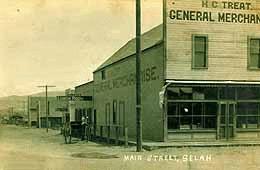On March 17, 1919, Yakima County commissioners validate the previous week's vote by Selah residents to incorporate their town. Strangely enough, the town's population has grown by half in recent months, raising it to just over the 300-resident threshold required by law for incorporation. This anomaly apparently goes unnoticed as the commissioners approve Selah's incorporation.
Trailblazers
In 1905, Frank Charbonneau built and opened a small store at a trail crossroads in the Selah Valley to provide goods and services for people who worked in the nearby alfalfa and hops fields. The store was only in operation for two years, but by the time it closed in 1907, A. E. Treat (1876-1949) had opened a mercantile business across from it. The two-story building had a meeting room on the upper floor.
That same year, Swedish immigrants Gus Remington (1876-1950) and Olaf Larson invested in land near the crossroads, and built a third building, which they named the Selah Trading Company. They then built a feed store and a hotel nearby, but before the village had a chance to grow, most of it burned down in a fire in 1908.
Remington and Larson built a new store, the Selah Mercantile Company, and other residents built a new hotel. Remington then began placing ads in Swedish newspapers in the Midwest, enticing other immigrants to come farm the fertile Selah Valley. Soon, he was helping new arrivals start their own businesses, and by 1912 the small community had a bank, a drug store, a livery stable, a meat market, and even a newspaper.
Town Growth
In 1913, an interurban rail line was completed from North Yakima (shortly to be renamed Yakima), the county seat located just south of Selah across the Naches River, furthering growth in the community. By this time, the blacksmith shop had already been converted into an auto repair shop, and local farmers were transporting their crops in trucks instead of horse wagons. Children were being taught in a brand new brick school, which graduated its first class of nine students in 1914.
By 1918, Selah boasted a population of nearly 200 residents, and the newspaper began promoting incorporation. Unfortunately, the town needed 300 residents to meet to meet the legal threshold for incorporation, and it was far short of that number.
Not wanting to wait for 100 newcomers to move to town, local boosters tried a different approach: they fudged the numbers. Years later, some of the men joked about how they "grew" their census by waiting until the fall harvest, when scores of itinerant workers filled the valley gathering apples and other crops. No sooner had some of these men jumped off of slow-moving freight trains than they were added to the rolls.
Making It Official
Armed with a tally of 310 "residents," Selah promoters held a caucus in February 1919, to see if the townsfolk wished to incorporate. The election was then held in Oleson's Shoe Shop on March 11, 1919, and of the 63 citizens who were present, all of them voted yes. Elmer Dahlin (1885-1979) was elected mayor, George Eyler (1885-1960) became treasurer, and five men were elected to the city council.
On March 17, 1919, the Board of County Commissioners of Yakima County validated the results, making Selah a municipality of the fourth class.
The following year, an assessor visited Selah, and wondered why the town's population had dropped so dramatically since the election. Townsfolk shrugged it off and blamed it on people moving away. Suspicions were raised, but the county commissioners never called for a recount.

